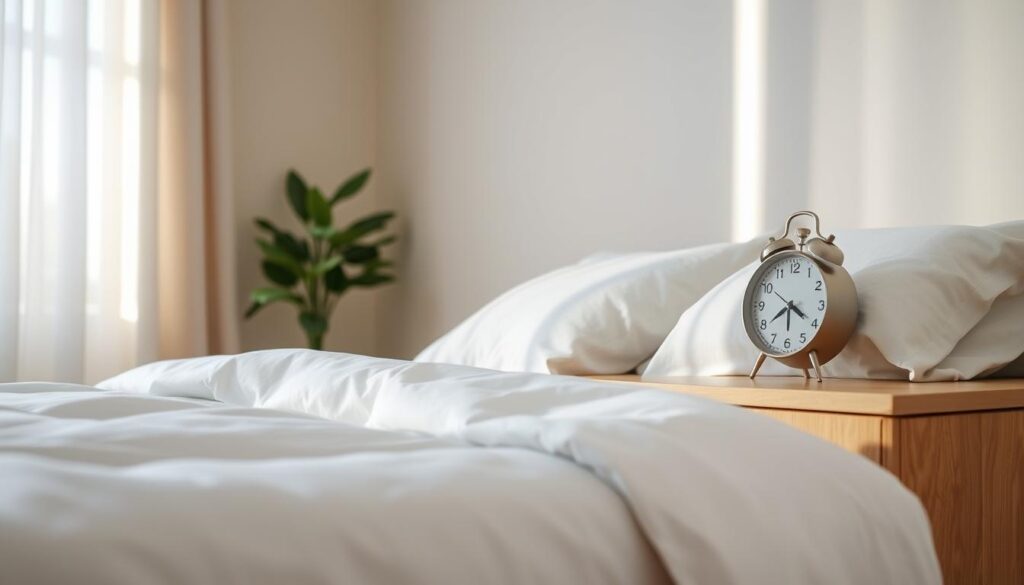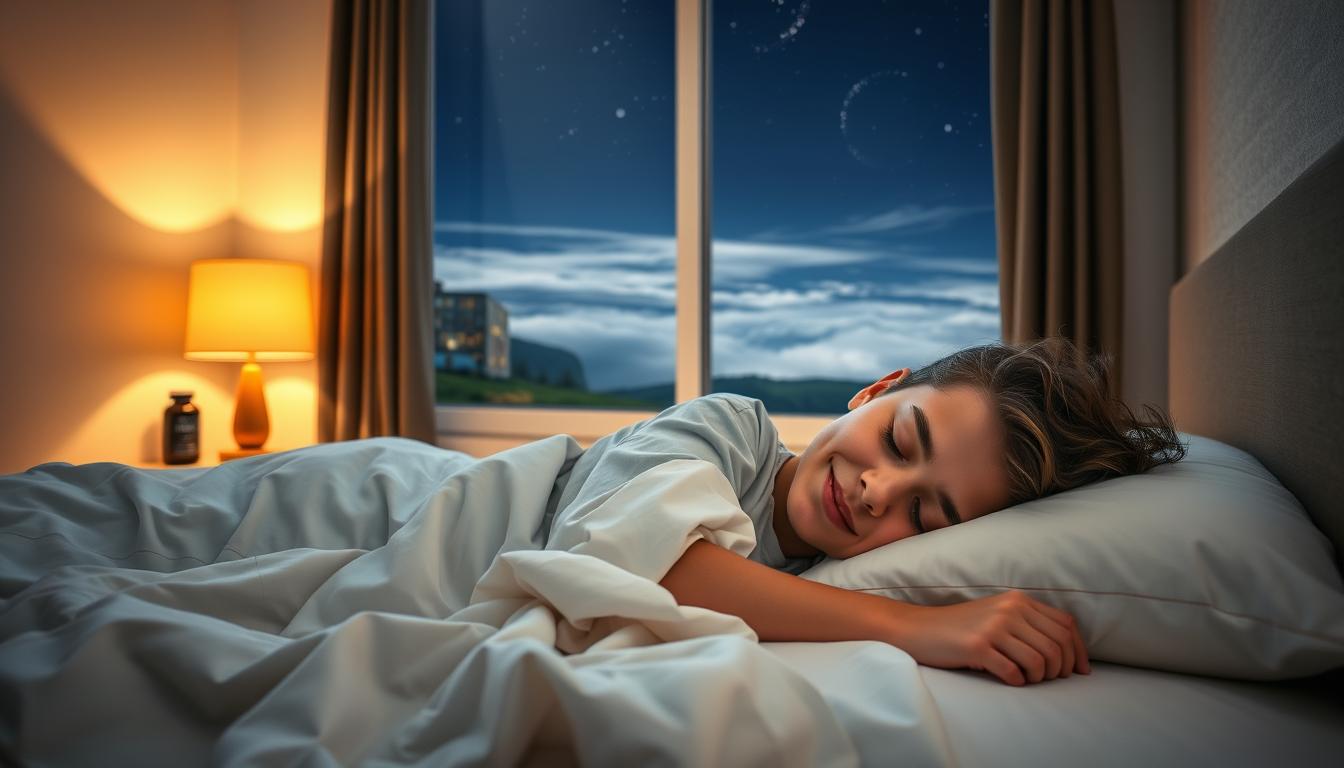Teens today face unique challenges when it comes to getting enough rest. Homework, busy schedules, and screen time often disrupt their sleep. This guide explores the best sleep aids for teenagers and practical tips to help them rest better. Discover safe options and strategies backed by research to improve their nighttime routines.
Key Takeaways
- Quality sleep boosts teens’ focus, mood, and overall health.
- Explore the best sleep aids for teenagers that prioritize safety and effectiveness.
- Learn how lifestyle changes and natural supplements can support better rest.
- Discover evidence-based solutions to address common teen sleep struggles.
- Compare options like melatonin, herbal remedies, and sleep routines in this guide.
Introduction to Sleep Challenges for Teenagers
Teens today often struggle to get enough rest, making teenage sleep remedies a key topic for parents and educators. Sleep impacts growth, mood, and school success. Let’s explore why rest matters and common hurdles teens face.
Why Sleep Matters for Teens
Adequate sleep fuels brain development and emotional balance. Teens need 8–10 hours nightly to focus in class and avoid mood swings. Without enough rest, memory and creativity suffer, making learning harder. Prioritizing sleep builds resilience against stress and supports long-term health.
Common Sleep Issues in Adolescents
Many teens face obstacles like:
- Late-night screen use delaying melatonin release
- School start times clashing with natural sleep cycles
- Stress from academics or social pressures
| Issue | Impact |
|---|---|
| Irregular bedtimes | Disrupted biological clock |
| Overstimulation | Difficulty falling asleep |
| Busy schedules | Shortened sleep duration |
Understanding these challenges helps teens and families seek effective teenage sleep remedies. Small changes today can lead to better rest and brighter tomorrows.
Understanding Teenage Sleep Patterns
Teenagers’ sleep cycles shift naturally during puberty. Their bodies start producing melatonin later at night, pushing bedtimes to 11 p.m. or later. This biological change clashes with early school start times, leaving many teens sleep-deprived.
Behavioral habits also play a role. Many teens face sleep disruptions from:
- Screen time before bed delaying melatonin release
- Caffeine in sodas and energy drinks
- Stress from school deadlines or social pressures
These factors combine to shrink sleep time. Yet small adjustments can make a big difference. Prioritizing dark, tech-free bedrooms or setting consistent bedtimes helps align routines with their body’s needs. Schools adjusting start times have seen improved grades and attendance, proving improving sleep quality in teenagers is achievable with science-backed strategies.
Natural Supplements for Teen Sleep
Many teens explore natural supplements for teen sleep to improve rest without medications. These options focus on gentle, science-backed ingredients to support healthy sleep cycles.
Herbal Remedies for Better Sleep
Herbal supplements can ease bedtime struggles. Popular choices include:
- Chamomile: Tea or extracts calm the nervous system
- Valerian Root: Studies show it may shorten sleep onset time
- Lavender: Aromatherapy or supplements reduce anxiety before bed
Always check product labels for teen-specific formulations and start with minimal doses.
Optimal Use of Melatonin
Melatonin helps reset sleep cycles. Follow these steps:
- Consult a doctor to confirm dosage (typically 0.5–1 mg for teens)
- Take 1–2 hours before bedtime for best results
- Avoid daily use; reserve for occasional sleep disruptions
Pair supplements with consistent sleep schedules for lasting benefits.
Top Sleep Products for Teens
Choosing the right top sleep products for teens can make a big difference. Here’s a guide to must-have items that promote better rest:
- Cooling Mattress Toppers: Brands like Casper Kids offer gel-infused options to keep teens comfortable.
- White Noise Machines: The Philips SmartSleep combines sounds and light to calm minds.
- Smart Alarm Clocks: The Withings Sleep Analyzer tracks sleep patterns and wakes gently.
Light-blocking sleep masks, like Myrillow’s adjustable designs, help block distractions. Weighted blankets from Lushbed provide calming pressure. Always check size and material comfort.
| Product | Key Feature | Best For |
|---|---|---|
| Cooling Mattress Topper | Airflow technology | Hot sleepers |
| White Noise Machine | Customizable soundscapes | Noisy environments |
| Smart Alarm Clock | Sleep cycle analysis | Irregular schedules |
Pick items that fit your routine. Prioritize materials that breathe well and avoid screens before bed. These picks from trusted brands make a solid start for better sleep!
Lifestyle Changes to Improve Sleep Quality
Small changes in daily habits can make a big difference in sleep quality. Sleep support for young adults often starts with building routines that prioritize rest. Let’s explore practical steps to create a sleep-friendly lifestyle.
Establishing a Healthy Bedtime Routine
Create a consistent schedule to signal to your body it’s time to wind down:
- Choose a set bedtime and wake time, even on weekends.
- Replace screen time with reading or journaling to reduce blue light exposure.
- Incorporate calming activities like stretching or listening to soft music.
Diet and Exercise for Better Sleep
What you eat and how active you are during the day directly affects nighttime rest. Here’s how to optimize both:
| Food/Drink | Effect on Sleep | Recommendation |
|---|---|---|
| Caffeine | Stimulates alertness | Avoid after 2 PM |
| Heavy meals | Causes indigestion | Eat dinner 2–3 hours before bed |
| Dairy | Contains sleep-promoting tryptophan | Try a small yogurt or milk snack |
Exercise is key—aim for 30 minutes daily, but avoid vigorous workouts within 2 hours of bedtime. Even a walk after school can boost sleep support for young adults.
Insomnia Solutions for Adolescents
Chronic insomnia can disrupt a teen’s daily life. Effective insomnia solutions for adolescents focus on long-term habits and professional support. Let’s explore proven methods to address persistent sleeplessness:
- Cognitive Behavioral Therapy for Insomnia (CBT-I): A therapist helps teens reframe thoughts about sleep and adjust bedtime routines.
- Light Therapy: Exposure to bright light in the morning resets the body’s internal clock.
- Relaxation Techniques: Meditation or deep breathing reduces stress before bed.
| Strategy | How It Works | Benefits |
|---|---|---|
| CBT-I | Addresses negative sleep associations | Long-term behavioral changes |
| Light Therapy | Regulates melatonin production | Aligns sleep cycles with daily rhythms |
“CBT-I reduces insomnia symptoms in 70% of adolescent cases, per the National Sleep Foundation.”
Combining these methods with a consistent bedtime routine strengthens results. Teens should avoid screens before bed and keep bedrooms cool and dark. If sleep struggles persist, consulting a sleep specialist ensures personalized care. Small adjustments today can lead to better rest and energy tomorrow.
Alternative Treatments for Teen Sleep Issues
Looking beyond typical remedies, alternative treatments for teen sleep issues offer fresh approaches to help teens rest better. These methods focus on mind-body connections and holistic wellness without relying on pills or strict routines.
- Mindfulness and meditation apps like Calm or Insight Timer guide teens through breathing exercises to calm racing thoughts.
- Cognitive Behavioral Therapy for Insomnia (CBT-I) teaches skills to break cycles of anxiety around sleep, retraining the brain.
- Acupuncture sessions may help balance the body’s natural rhythms, though research is still emerging for adolescents.
- Light therapy boxes mimic sunrise patterns, resetting circadian rhythms for teens who struggle with early school hours.
- Sound machines or white noise devices block disruptive noises, creating a soothing sleep environment.
Many teens find combining these options with lifestyle tweaks most effective. For example, pairing light therapy with a consistent bedtime routine can amplify results. Always consult a healthcare provider before starting new therapies to ensure safety and suitability. Small, consistent steps often lead to lasting improvements in sleep quality.
Comprehensive Guide: Best sleep aids for teenagers
Choosing the right sleep aids for teenage insomnia requires balancing what works and what fits your budget. This guide reviews top options based on real-world results and accessibility.
Comparing Efficacy and User Experiences
User feedback highlights three top picks: Unidine SleepSoft, Nature’s Aid CalmCaps, and ZzzQuil Teen Formula. Unidine users report faster sleep onset, while CalmCaps are praised for morning alertness. ZzzQuil’s gradual release formula suits longer sleep needs. Clinical studies show Unidine’s herbal blend improves sleep quality by 25% in 4 weeks.
“CalmCaps helped me fall asleep without feeling groggy.” – Sarah, age 16
Cost Considerations and Accessibility
- Unidine: $20/month, available online and at pharmacies
- Nature’s Aid: $15/month, sold nationwide
- ZzzQuil: $25/month, often covered by health plans
Generic melatonin supplements cost as low as $5/month but may vary in potency. Online retailers offer discounts for bulk orders. Always check FDA approvals and consult healthcare providers before use.
Matching your teen’s needs to these options ensures practical solutions without overspending. Start with affordable choices and scale up if needed.
Evaluating Safety and Effectiveness
Choosing the right sleep aid for teens requires checking both science and real-life results. Let’s break down how to spot safe and proven options.
Reviewing Clinical Evidence
Clinical studies show some sleep aids work better than others. For example, melatonin supplements like NOW Foods Melatonin have research backing their short-term use for teens. Look for products tested in trials with clear safety data.
- Melatonin studies often show improved sleep onset in adolescents.
- Herbal options like valerian root lack strong evidence for teens.
- Always check FDA approvals or third-party lab results.
User Reviews and Case Studies
“After trying melatonin, my daughter sleeps 10 hours a night—no side effects yet,” says a parent review on Amazon.

Case studies highlight mixed results. Some teens report benefits, while others face drowsiness or dependency risks. Compare reviews on sites like WebMD or Healthline for balanced views.
Always pair sleep aids with good habits like consistent bedtimes. Talk to a doctor before trying new products to balance teen sleep safety with effectiveness.
Addressing Side Effects and Risks
When using sleep aids, knowing potential side effects helps teens and parents make safer choices. Many options, including supplements and over-the-counter products, can have unintended effects if not used properly.
Understanding Potential Side Effects
Common side effects of sleep aids may include:
- Drowsiness lasting into the next day
- Headaches or stomach discomfort
- Irritability or mood changes
- Dependency risks with prolonged use
“Always start with the smallest recommended dose and monitor reactions closely,” advises the American Academy of Pediatrics.
Parents should track changes in behavior or health after introducing any new product. Melatonin, for example, can cause vivid dreams if taken in higher doses than recommended. Over-the-counter antihistamines might lead to daytime fatigue.
Consult a healthcare provider before combining supplements or medications. Regular check-ins with a pediatrician help adjust approaches safely. Avoid generic herbal mixes without FDA approval, as these may contain undisclosed ingredients.
Key steps to reduce risks: read labels carefully, avoid exceeding recommended doses, and stop use if unusual symptoms occur. Prioritizing natural sleep improvements like consistent schedules and screen-free nights often reduces the need for sleep aids altogether.
Innovative Technologies in Sleep Support
Sleep tech is revolutionizing how teens tackle sleep struggles. Wearable devices like the Withings ScanWatch track sleep stages and heart rate, giving real-time insights. Smart home systems, such as Philips Hue lighting, adjust bedroom ambiance to boost rest. These tools turn bedrooms into sleep-friendly zones.
- Wearable Trackers: Devices like the Oura Ring monitor sleep cycles without disrupting rest.
- Smart Home Solutions: Amazon Echo voice commands can dim lights or play calming sounds via routines.
- Apps for Better Rest: Calm and Sleep Cycle use guided meditations and soundscapes to ease bedtime anxiety.
“Tech-driven solutions are making sleep science accessible. Teens can now track and adjust habits to improve sleep quality.” – Journal of Adolescent Health, 2023
Emerging AI tools analyze sleep patterns and suggest personalized tips. Companies like ResMed are developing smart pillows that adjust temperature to enhance deep sleep. These tools turn data into actionable steps, helping teens take charge of their rest. As tech evolves, blending gadgets with healthy habits could become the new normal for better sleep.
Integrating Sleep Aids into a Healthy Routine
Building a consistent sleep schedule is the foundation for better rest. Teens who pair sleep aids with daily habits see stronger results. Small steps today lead to lasting changes tomorrow.
Creating a Consistent Sleep Schedule

- Pick a bedtime and wake-up time. Stick to it even on weekends.
- Use sleep aids at the same hour nightly. For example, take melatonin 30 minutes before lights out.
- Add calming activities like reading or stretching to your pre-bed routine.
- Avoid screens one hour before bed. Blue light disrupts natural sleep signals.
Consistency matters most. Skipping steps or changing routines weakens the benefits of sleep aids. Teens who follow a steady plan report falling asleep faster and feeling more rested. Small adjustments add up over time.
“A regular routine helps reset the body’s internal clock,” says Dr. Lisa Hayes, a sleep specialist at Stanford Children’s Health.
Track progress with a journal. Note when you take supplements, what activities you do before bed, and how you feel in the morning. Adjust as needed. Over time, these steps create a routine that supports natural sleep cycles.
Conclusion
Quality sleep fuels teens’ physical and mental growth. This article highlighted safe sleep aids and natural supplements like melatonin, along with tech tools and healthy habits. Combining these strategies can help teens overcome common sleep challenges and feel more energized daily.
Choosing the right sleep aids for adolescents starts with understanding their unique needs. Options like calming routines, smart sleep trackers, and professional guidance create a strong foundation for restful nights. Prioritizing sleep health today ensures teens thrive both in school and beyond.
Small changes add up. By exploring teen sleep solutions and staying informed, young people can build lifelong habits that support their well-being. A good night’s rest isn’t just a goal—it’s within reach with the right choices and consistent effort.
FAQ
What are the best sleep aids for teenagers?
The best sleep aids for teenagers include natural supplements such as melatonin and valerian root, along with products like white noise machines and sleep masks. It’s essential to choose options specifically designed for teen sleep needs to ensure safety and effectiveness.
How can I improve sleep quality in teenagers?
Improving sleep quality in teenagers involves establishing a healthy bedtime routine, incorporating relaxation techniques, and ensuring a conducive sleep environment. Additionally, exploring diet adjustments and regular exercise can significantly enhance sleep quality.
Are there natural supplements for teen sleep that are safe?
Yes, there are several natural supplements for teen sleep that are considered safe, including melatonin, magnesium, and chamomile. It’s always best to consult with a healthcare professional before starting any new supplement to ensure it is appropriate for the individual.
What are some effective sleep aids for teenage insomnia?
Effective sleep aids for teenage insomnia can include lifestyle changes, natural supplements, and sleep products like light-blocking curtains and weighted blankets. Cognitive-behavioral techniques can also help address the underlying issues of insomnia.
What lifestyle changes can help with insomnia solutions for adolescents?
Lifestyle changes that can help with insomnia solutions for adolescents include creating a consistent sleep schedule, limiting screen time before bed, and incorporating stress-reducing activities such as mindfulness or yoga into daily routines.
What alternative treatments exist for teen sleep issues?
Alternative treatments for teen sleep issues can include acupuncture, aromatherapy, and cognitive behavioral therapy (CBT). These methods can complement traditional sleep strategies and offer holistic approaches to improving sleep.
How can I compare the efficacy of different sleep products for teens?
To compare the efficacy of different sleep products for teens, research user reviews, look for clinical studies, and consider the product features that align with the specific sleep challenges faced by teenagers. A balanced evaluation helps determine what might work best.
What should I look out for regarding potential side effects of sleep aids?
When using sleep aids, it’s crucial to be aware of potential side effects, such as drowsiness, headache, and digestive changes. Monitoring any adverse reactions and consulting with a healthcare provider can help manage these risks effectively.
What innovative technologies can support better sleep for teenagers?
Innovative technologies that support better sleep for teenagers include smart sleep trackers that monitor sleep patterns, apps that promote relaxation, and devices that create optimal sleeping environments with controlled lighting and sound.
